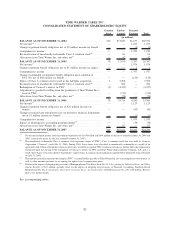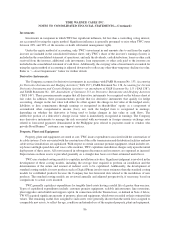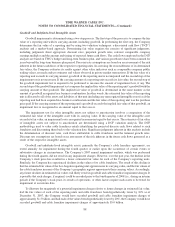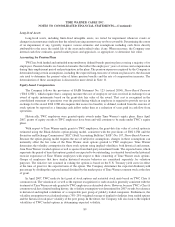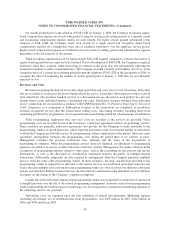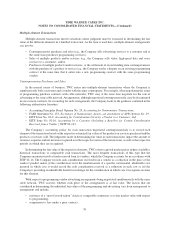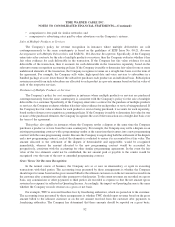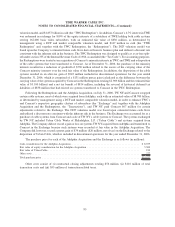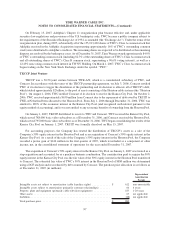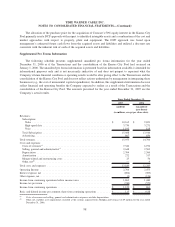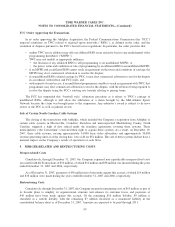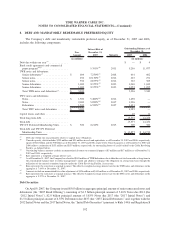Time Warner Cable 2007 Annual Report Download - page 97
Download and view the complete annual report
Please find page 97 of the 2007 Time Warner Cable annual report below. You can navigate through the pages in the report by either clicking on the pages listed below, or by using the keyword search tool below to find specific information within the annual report.• comparison to fees paid for similar networks; and
• comparison to advertising rates paid by other advertisers on the Company’s systems.
Sales of Multiple Products or Services
The Company’s policy for revenue recognition in instances where multiple deliverables are sold
contemporaneously to the same counterparty is based on the guidelines of EITF Issue No. 00-21, Revenue
Arrangements with Multiple Deliverables, and SAB No. 104, Revenue Recognition. Specifically, if the Company
enters into sales contracts for the sale of multiple products or services, then the Company evaluates whether it has
fair value evidence for each deliverable in the transaction. If the Company has fair value evidence for each
deliverable of the transaction, then it accounts for each deliverable in the transaction separately, based on the
relevant revenue recognition accounting policies. If the Company is unable to determine fair value for one or more
undelivered elements of the transaction, the Company recognizes revenue on a straight-line basis over the term of
the agreement. For example, the Company sells video, high-speed data and voice services to subscribers in a
bundled package at a rate lower than if the subscriber purchases each product on an individual basis. Subscription
revenues received from such subscribers are allocated to each product in a pro-rata manner based on the fair value of
each of the respective services.
Purchases of Multiple Products or Services
The Company’s policy for cost recognition in instances where multiple products or services are purchased
contemporaneously from the same counterparty is consistent with the Company’s policy for the sale of multiple
deliverables to a customer. Specifically, if the Company enters into a contract for the purchase of multiple products
or services, the Company evaluates whether it has fair value evidence for each product or service being purchased. If
the Company has fair value evidence for each product or service being purchased, it accounts for each separately,
based on the relevant cost recognition accounting policies. If the Company is unable to determine fair value for one
or more of the purchased elements, the Company recognizes the cost of the transaction on a straight-line basis over
the term of the agreement.
This policy also applies in instances where the Company settles a dispute at the same time the Company
purchases a product or service from that same counterparty. For example, the Company may settle a dispute on an
existing programming contract with a programming vendor at the same time that it enters into a new programming
contract with the same programming vendor. Because the Company is negotiating both the settlement of the dispute
and a new programming contract, each of the elements is evaluated to ensure it is accounted for at fair value. The
amount allocated to the settlement of the dispute, if determinable and supportable, would be recognized
immediately, whereas the amount allocated to the new programming contract would be accounted for
prospectively, consistent with the accounting for other similar programming agreements. In the event the fair
value of the two elements could not be established, the net amount paid or payable to the vendor would be
recognized over the term of the new or amended programming contract.
Gross Versus Net Revenue Recognition
In the normal course of business, the Company acts as or uses an intermediary or agent in executing
transactions with third parties. The accounting issue presented by these arrangements is whether the Company
should report revenue based on the gross amount billed to the ultimate customer or on the net amount received from
the customer after commissions and other payments to third parties. To the extent revenues are recorded on a gross
basis, any commissions or other payments to third parties are recorded as expense so that the net amount (gross
revenues less expense) is reflected in Operating Income. Accordingly, the impact on Operating Income is the same
whether the Company records revenue on a gross or net basis.
For example, TWC is assessed franchise fees by franchising authorities, which are passed on to the customer.
The accounting issue presented by these arrangements is whether TWC should report revenue based on the gross
amount billed to the ultimate customer or on the net amount received from the customer after payments to
franchising authorities. The Company has determined that these amounts should be reported on a gross basis.
92
TIME WARNER CABLE INC.
NOTES TO CONSOLIDATED FINANCIAL STATEMENTS—(Continued)


